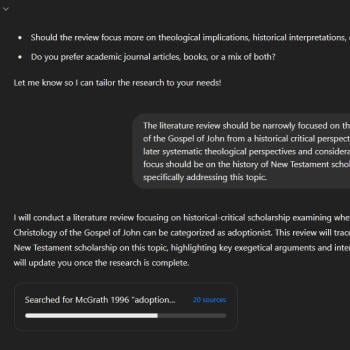The next issue of Biblical Archaeology Review will be out in a few days. It includes an article by me about the story of the woman accused of adultery found in John 8 in some manuscripts. I repeatedly found in working in my forthcoming book that asking what Jesus learned from women, both his family and friends and those he only met briefly, unlocked possible meanings in the text that not only I but interpreters in general had missed. I don’t know whether I have come up with the definitive explanation of Jesus writing with his finger in the story. But I believe I offer one that makes excellent sense of the details of the story against the backdrop of that time, that has never to my knowledge been proposed before. When stories have been studied for almost 2,000 years that is an extremely rare occurrence indeed.
I obviously want you to read the article, while also saying enough here to make it seem worth your while to do so even if it requires going to your local library or otherwise getting access to a magazine that you don’t subscribe to. Part of me just wants to give you the last sentence and see what you can deduce from it. I think the story is, ultimately, a bit like a detective story, in which Jesus has been presented with a case that has at once too many and too few clues. Here’s the last sentence of the article: “Jesus’s action makes sense when considered in its context—not only the historical, cultural, and geographical context, but the architectural context as well. His action has puzzled readers because interpreters failed to observe the things to which archaeologists dedicate so much of their professional attention. We failed to notice the floor, even when Jesus’s finger was pointing directly to it the entire time.”
Does that give you, my blog readers, enough clues to figure out what I suggest? Here are some other questions that I think are important keys to unlocking answers to why Jesus “wrote” on the ground or floor in the way John 8 says:
What did were the Pharisees known for emphasizing, and what does that suggest about their aims in bringing the case to Jesus? What does it allow us to conclude about the precise situation when they specify that the Law required her to be stoned? What have antisemitic misrepresentations of the Pharisees and of Judaism more generally caused us to miss or misinterpret?
What setting have you seen the story depicted in in movies and on TV? How does the actual location of the story specified in the Gospel of John require a rethinking of what is going on and what Jesus’ action might have indicated? What ground or floor was he in fact drawing his finger across? Where does that specific floor or ground get mentioned elsewhere in the Bible and how is that potentially relevant to this story?
Are those enough clues to lead you to see where I go with this? If not, then you’ll just have to read the article, and/or the book. Here is what I say about the story after a lengthy exploration of it in What Jesus Learned from Women:
Rereading this familiar story again, now as part of an investigation of what Jesus learned from women, I feel ashamed, being suddenly made aware that I had not truly seen and heard the woman at the center of this story before now. Not really. All the pieces of the puzzle I have assembled in this chapter were there in the evidence available. They are insufficient to solve the case, but they are more than adequate to bring the woman into clearer focus than we do. We allow the camera angle of the ancient director, as it were, to lead our eyes to the male protagonists. The woman is brought before us, probably naked, and even so we fail to see her—and not because we, like Jesus, keep our eyes on the ground in the interest of modesty and respect. Jesus stoops down and remains quiet, and even so we pepper him with questions like the woman’s accusers, and yet never call for her testimony, never piece it together from the few details provided in the story and in relevant sources of cultural and historical information. I wish Jesus could have done more for this woman, but he did better by her than I ever have as a reader of her story. He subtly yet clearly made room for us to hear her. We, like the ancient court that was deciding her fate, have refused to listen, focusing our attention instead where the male accusers direct it.
It sounds as though What Jesus Learned from Women will also be out within the next few days. The book can currently be pre-ordered through the publisher’s website. I am hoping to see the book used in university and seminary courses, church discussion groups, book clubs, and other contexts, as well as read by interested individuals. I genuinely think it is the most important and worthwhile book I have written thus far, and I cannot wait to find out whether others feel the same way. If you’d be interested in having me do a Zoom visit with a class or other group that decides to read and discuss the book together, please let me know!
Also related to the book, I doubt that there is anyone else quite as eager as me to have a copy of the amazing cover art from my book on their wall. But even if you cannot match quite my level of enthusiasm, you can still get yourself one and be happy! Artist Macey Dickerson now has prints for sale in multiple sizes and forms. Take a look at what is on offer on the Society 6 art website and get yourself one!
Here are some other items that may be of interest (not only about Jesus and women but also other biblical women, women in subsequent Christianity, and the historical Jesus and Christology more broadly):
First, let me mention Nathan Shedd’s talk that is coming up on John the Baptist. Also don’t miss what Larry Schiffman recently shared about John the Baptist and purity.
Jesus Invited Women to Take Their Place
Janelle Peters on Ancient Corinth, Women, and Veils
The Kingdom of God is In Your Midst
The De-Mystification of Christian Origins
Is Judith Historically Inaccurate?
Jael’s Gender Ambiguity in Judges 4-5
Review of Justo Gonzales’ book on the Lord’s Prayer
Beeson Divinity School has a new Center for Women in Ministry
What Are They Saying About the Parables? (new edition)
The Jerusalem Temple on Mount Gerizim
https://johntsquires.com/2021/02/22/2740/
Forty days, led by the Spirit: Jesus in the wilderness (Mark 1; Lent 1B)
A Reasonable, Knowledgeable, and Compassionate Man
From Bob Cornwall:
From Ian Paul:
The Startling Authority of Jesus in Mark 1
The Temptation and Preaching of Jesus in Mark 1
The baptism, temptation and preaching of Jesus in Mark 1 video
The Cost of Discipleship in Mark 8
What is Transfigured in Mark 9?
Jesus as the Word become Flesh in John 1













